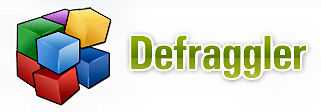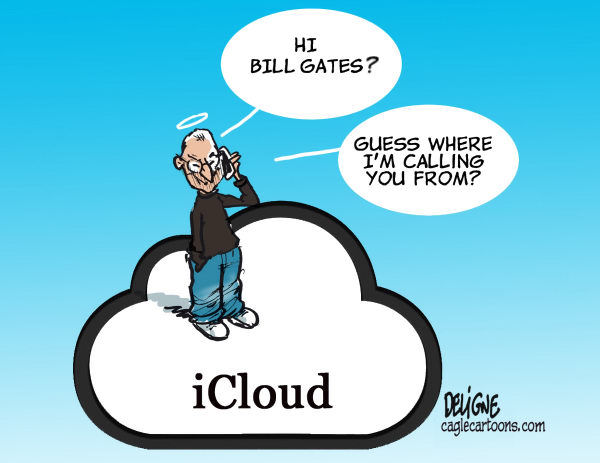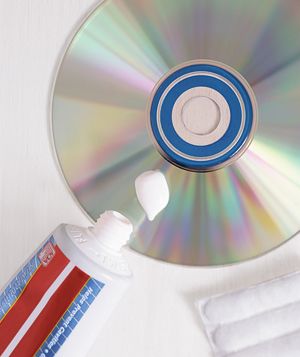|
Radschool Association Magazine - Vol 38 Page 4 |
||||
|
Privacy Policy | Editorial Policy | Profit Policy | Join the Association | List of Members | Contact us | Index | Links |
||||
|
Computers and stuff
Sam Houliston. |
||||
|
|
||||
|
Improve performance by defragmenting your hard disk??
Fragmentation occurs when the computerís
file system cannot or will
not allocate enough contiguous space to store a complete file as a unit.
Instead, the file system puts parts of the file in gaps between other
files (usually those gaps exist because they held a smaller file that
has been previously deleted). When reading data from a conventional electro-mechanical hard disk
drive, the disk controller must first position the head to the track
where a given fragment resides, which it does relatively slowly and then
wait while the disk platter rotates until the fragment reaches the head. The common belief is that you should regularly de-fragment your
hard disk so it doesnít have
to do all that extra work looking for the Ďpartsí of a file before it
(the file) can be opened. This was definitely the case some time ago,
(pre XP days) but today, it is not nearly such a problem. The new file systems such as NTFS are designed to decrease the
likelihood of fragmentation and improvements in modern hard drives such
as RAM cache, faster platter
(disk) rotation speed, command queuing and greater data density reduce
the negative impact of fragmentation on system performance.
Additionally, modern systems profit enormously from the huge disk
capacities currently available, since partially filled disks fragment
much less than full disks and on a high-capacity HDD, the same partition
occupies a smaller range of cylinders, resulting in faster seeks. If you have a machine without a mechanical hard drive, ie: a flash
drive, you donít have this problem. Flash Drives have no moving parts
and so random access of file fragments does not suffer this delay making
defragmentation to optimize these drives unnecessary. Furthermore, since
flash memory can be written to only a limited number of times before it
fails, defragmentation is actually detrimental. This applies to memory
sticks, camera memory cards etc, they should not be defragmented as all
that does is hasten the failure of the device. With a mechanical drive, no matter what you do, the average access time
can never be lower than a half rotation of the platter, and platter
rotation (measured in rpm) is the speed characteristic of HDDs which has
experienced the slowest growth over the decades. The faster the rotation
speed of the HDD the quicker the computer will access and load files. So is it really worth defragmenting your HDD??
Window has had a Defrag utility for some time, but starting with Windows Vista, Microsoft has made it run automatically at a scheduled time. This is usually set to run at 1.00am, but you can change the schedule to run at a time to suit you, once a month should be sufficient. There are many other Defrag programs on the market, some free, some you can buy relatively cheaply, but you have to be careful with these as they can actually slow down your machine.
Hereís how!!
Starting with Windows XP, Microsoft added a ďPrefetchĒ to their Windows program. Prefetch is a component of the Memory Manager that speeds up the Windows boot process and shortens the amount of time it takes to find, load and start programs. From Windows Vista, SuperFetch and ReadyBoost were added which monitor the way you use your computer over time and loads the majority of the files and data needed by them into memory so that they can be accessed very quickly when needed. This list is updated often, depending on what you do with your computer and windows stores the data in a folder named C:\Windows\Prefetch.
Windows stores the files in the Prefetch folder in
a pre-set way so they can be very quickly accessed. Windowsí Defrag
knows this and leaves them alone, a lot of the Ďafter marketí ones donít
and will change the order of the files. Windows also ďlocksĒ files in a
pre-set position
If you install and/or un-install a lot of programs regularly and your hard drive is 100Gig or less, then you should run the Windows Defrag perhaps once a week. If, on the other hand, you have a relatively large hard drive and you use your computer for emails, Facebooking, writing letters, Googling etc, then once a month is plenty. Set the schedule for a time when the computer will be switched on and not used. A Defrag can take about 30 minutes and since Vista, Microsoft has made the Defrag utility pause when it detects computer usage Ė this can extend the Defrag time to several hours.
|
||||
|
A simple friend brings a bottle of wine to your party. A real friend comes early to help you cook and stays late to help you clean.
|
||||
|
Cloud computing
Last issue we mentioned Cloud Computing, thereís some more info HERE.
Whatís going on inside your computer.
Has your internet connection become slower than it should be? There may be a chance that you have some malware, spyware, or adware that is using your internet connection in the background without your knowledge. If youíve only got a small monthly traffic allowance (uploads and downloads) from your Internet Provider, this could be chewing up your valuable monthly quota and costing you money.
Hereís how to see whatís going on under the bonnet.
If you are running a PC using Windows XP (with a minimum of Service Pack 2), Vista or Win 7, Microsoft has given you a free tool to keep an eye on things, itís called Netstat.EXE and it lives in the C:\Windows\System32 folder.
Hereís how you use it.
After youíve typed CTRL C, make sure your printer is turned on then open Word (or your word processor) and open the file activity.txt which you will find in drive C. Print the file. You can then check the contents and see what is going on.
This is what the netstat -abf 5 > activity.txt routine is all about.
Once youíve printed the file, you will see all the processes on your computer (browsers, IM clients, email programs, etc.) that have made an internet connection in the last two minutes, (or however long you waited before pressing CTRL C). It also lists which processes connected to which websites. If you see process names or website addresses with which you are not familiar, you can search for ďwhat is (name of unknown process)Ē in Google and see what it is. It might be a completely legitimate system function you didnít know about or a function of one of your running programs Ė or it could be a dud. If it looks like it is (a dud) you can use Google again to find out how to get rid of it.
Another way is to use the free program called CurrPorts. You get this from HERE. All you do is download the Zip file from the website, extract cports.exe and run it. There is no need to install it. CurrPorts runs under most versions of Windows and you can get both 32 bit and 64 bit versions. You will find more information about CurrPorts and how to use it on the above website.
|
||||
|
A simple friend doesn't know your parents' first names. A real friend has their phone numbers in his address book. |
||||
|
How to make a panoramic photo.
How often have you been in a wonderful scenic situation and wish you had a panoramic camera to be able to capture the complete view Ė not just a part of it. Some of the newer digital cameras have that facility, but if youíve still got the old camera youíve had for yonks, itís only wishful thinking Ė up till now.
Provided you are a Windows User, there is a free Microsoft program that will expertly combine two or more photos and produce a perfect panoramic photo for you.
Hereís how you do it.
First thing is to download and install the free Microsoft program called Microsoft ICE (Image Composite Editor) and you can do that from HERE
Now that you have the program, take your photos, starting from the left and working around to the right, or go the other way, doesnít matter, just make sure you overlap each one. This works a lot better if you have a tripod and can pan the camera from left to right (or right to left) keeping everything in the one plane. If you have one photo that was taken a little higher or lower than another, Ice will match them where they overlap and you will end up with a ragged top and/or bottom.
Next, save your photos into a directory in your computer (or you can work from the SD card if you wish) and open ICE. We have taken the 3 photos below to demonstrate how it works, these were taken not using a tripod so you will see the result.
|
||||
|
|
|
|
||
|
Open ICE
and click on FILE then click NEW PANORAMA. Navigate to the photos you
wish to include in your panorama, hold down the CTRL key, then click
them in any order, ICE has a look at them and sorts them out for you. When you
have them all selected, click OPEN down the bottom right hand corner of
your screen and you end up with the picture below. (Click it to see the
controls clearer).
|
||||
|
|
||||
|
Now, before you finish, there are a few househeeping tasks you should do....you can zoom in or out of the photo by using the wheel on your mouse or by moving the slider bar towards either the + or - up the top right of the photo.
|
||||
When
youíve done all that, and you are happy with the result, click Export to
Disk (unless you wish to publish it on a web site). ICE will ask you
where you want the finished result saved and ask you for a name for the
file. Fill all this in then click SAVE.
This is what you end up with. And Ė working with photos, if you use a tripod, the results are even better |
||||
|
|
||||
|
Ice is a
very easy program to use and has hundreds of uses. For example, if you
have an A3 document (or larger) that you want to shrink to A4, you can
scan bits of it and have ICE put it all together for you, then when itís
a JPG file you can make it any size you wish.
Have a fiddle with it, it will also work with video.
|
||||
|
BEAUTY PARLOUR: A place where women curl up and dye.
|
||||
|
Domain Names. The
Internet hasnít been with us for all that long, though now, how would we
get on without it?? Looking back, itís hard to realise that the first
domain name was registered on the 15th
March 1985 Ė only a bit
over 35 years ago. Most
people would assume that the first domain name was registered to a huge
computer company such as IBM or Texas Instruments or some other
monolithic company like GM or Exxon or MGM but no, the reality is the
first domain belonged to a small local computer company. In 1985,
shortly after domains were available for purchase by the public, the
small computer firm from Cambridge, Massachusetts, Symbolics, purchased
the very first one. Although Symbolics.com was the first domain name ever registered, it was
not the first ever created. Nordu.net, a name that was created by the
registry on January 1, 1985, was the first domain name of all-time and
used for the first root server (nic.nordu.net). Once domains were
allowed to be registered, however, Symbolics.com was the first name
taken. Symbolics,
Inc. placed their stake in the virtual soil of the budding internet and
into internet history with the purchase of its domain name, it became
the very first domain registration and the first commercial domain name
all in one swoop. As the internet had yet to gain any real traction
among the general populace, Symbolics, which designed
and manufactured a line of Lisp
machines, single-user computers optimized to run the
Lisp programming language,
was a lonely domain for quite some time. By 1992 a
mere 15,000 commercial domains had been registered, but by 2009, over 20
years later, a whopping 192 million domains names had been registered.
84 million of those registrations were for commercial domains. On the 21
January, 2012, there were 136,324,856 domain names currently registered
and 412,919,709 which had been used at one time or another but had now
been deleted. See
HERE. They
might have been first, but Symbolics didnít last the distance, the
Company faded into obscurity, but the name lived on and is now owned by
domain trader XF Investments. You can see the oldest domains names HERE
|
||||
|
CHICKENS:
|
||||
|
Moving web hosts. Netregistry.
Thereís a special part of the brain thatís called the Ďtoo-hard basket.í Itís a seemingly bottomless pit where dreams, fantasies and things that need to be done, but seem far too complex, are stored for a tomorrow that never comes.
In the
past, this was where the idea of moving web hosts would be filed away.
Thereís long been a perception that once you choose a web provider that
youíre stuck with them no matter what. Itís often looked like as less of
a marriage and more like a jail term Ė with no chance of parole.
These days, those commonly-held beliefs are far out of date. Netregistry say that choosing a hosting provider is no longer about sending your data into the digital abyss. If youíre getting poor service, constant downtime or the company is charging you like a wounded bull, then itís quite easy to find greener pastures - like to them for instance.
If you, as a small business owner, want to move from one ISP to another there is generally a checklist of things you should follow and as long as you follow it explicitly, the change will go pretty smoothly.
Like everything in small business itís about planning and understanding the situation. Generally you would purchase a hosting package with your new provider, thatís normally the first thing you do. You then have to make a decision on your email. Letís say your hosting package includes your email addresses (which is 95% of the time), youíve then got to recreate all of your mail accounts.
This is one of the ingredients that contributed to the idea of moving web hosts seeming to be hard. If you wind the clock back a decade, the concept of clicking into the options menu of an email client like Outlook would seem like an alien one. Now, itís a two-minute operation that your new provider can easily talk you through over the phone.
The easiest way to do it is to use the same passwords as you do with the old provider. If you want to use new passwords then all that does is give you an additional step later on. The next step is one where peopleís eyes have glazed over in the past, and where the concept of moving providers has quickly been shuffled towards being difficult. In reality that is not the case.
You then need to load up your site to your new provider. Normally your new provider will give you some kind of staging IP address or a web address so that you can test that your siteís all working correctly. If itís a straight HTML site, typically itís a straight copy from one server to another and everything should just work. If you are using a site thatís got some PHP scripting, and itís connected to a database, then youíve obviously got to recreate that with your new provider.
While this might sound like a complex step, you are going to be on the phone with someone who has migrated hundreds of sites over the years, and they will be able to streamline the process. Migrating a complex retail site, with display items, a data base, financial transactions etc is probably about an hourís work. Itís not massive. A big part of that is once youíve done it all, itís just testing and going through the pages to make sure everything is OK. If itís a transactional site, all your transactions are going to happen normally. Once youíve tested everything and itís working correctly, the final step will be to delegate the domain.
Once you make the jump to a new provider, thereís a brief period of between two and 24 hours where both sites will be running in parallel, depending on how itís set up. Some people might be seeing the old site and some might be seeing the new one. In a static site itís not an issue, you are just looking at the same information on the site and you can have both running simultaneously. If your site is a little more dynamic Ė with forums for instance Ė then you will want to lock the old site during the transition. This prevents users signing up on the old one while the new site is stretching its legs. Again, itís not a big deal.
The final part is where you fix up your mail clients. Itís simply a case of changing the server name in the options menu, which the person on the other end of the phone will talk you through.
In reality, the effort involved varies enormously depending on the site, your knowledge and the facilities provided by the new host. A simple site like the Radschool site, would be easy, trying to move Qantas or Myer or Grays Auctions would be quite a different story.
|
||||
|
Measurement converter in Word.
From Word 2003 (XP) onwards, Microsoft has added a very handy little measurement converter Ė and itís dead easy to use.
If you were doing a story which requires you to put measurements in both Metric and the old imperial format, normally you would have to use a calculator or open Excel to convert one to the other Ė well, if you know where to look, Word will do it for you easily.
Word converts the following. |
||||
|
|
||||
|
Letís say you want to convert 25.45 miles to klms, all you have to do highlight the 25.45 miles, right click, then select Additional Items and thereís your answer. When you double click the converted number, Word automatically inserts it into your document. So if you wanted to have both formats in your document, just type 25.45 miles into your story twice and convert one of them.
The only thing you have to be careful about is how you type the number to be converted. 25.45miles will not work, there has to be a space between the number and the word. Apart from that, itís a piece of cake. |
||||
|
|
||||
|
MOSQUITO:
|
||||
|
CD/DVD Cleaner
|
||||
|
||||


 , and once again, its Defrag program know this too and
also leaves them alone. An ďAfter-marketĒ Defrag will see these Locked
Files and will think them as being fragmented and will try and defrag
them. This can really upset the apple cart.
, and once again, its Defrag program know this too and
also leaves them alone. An ďAfter-marketĒ Defrag will see these Locked
Files and will think them as being fragmented and will try and defrag
them. This can really upset the apple cart.



